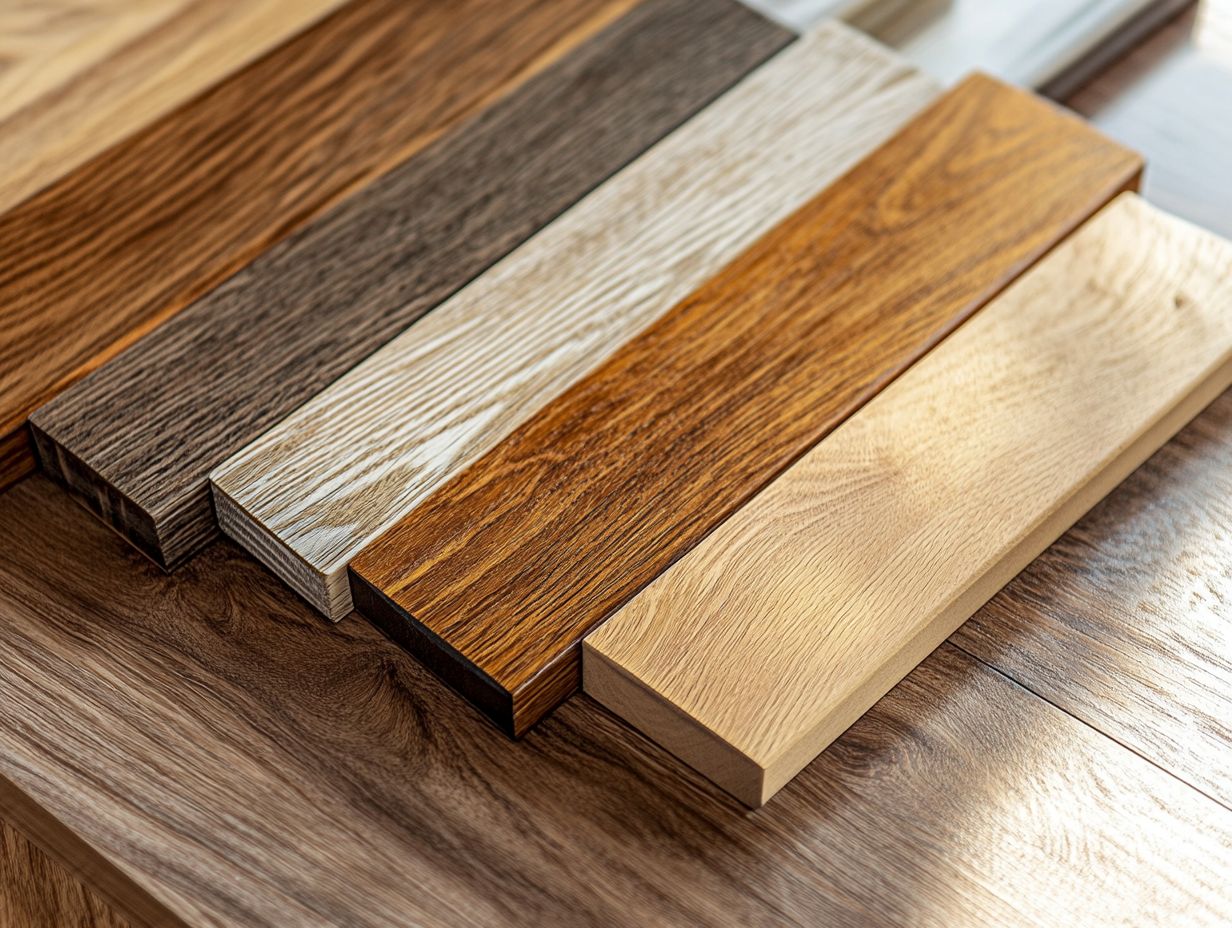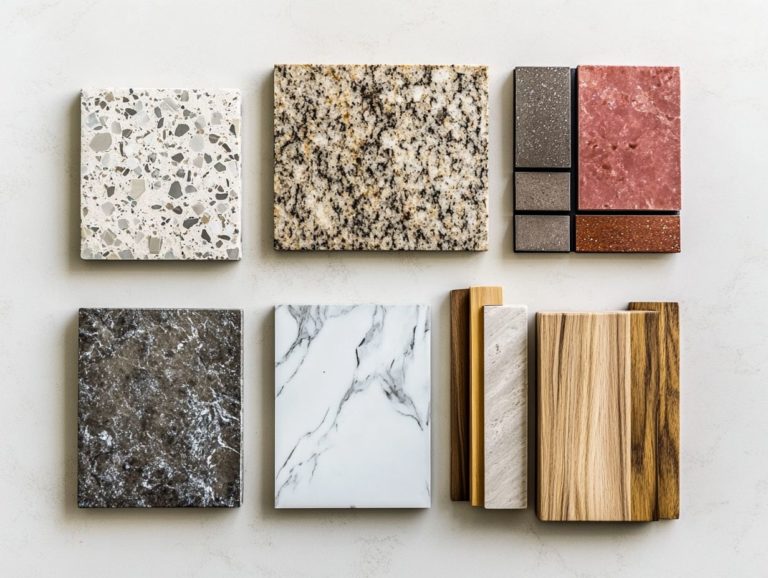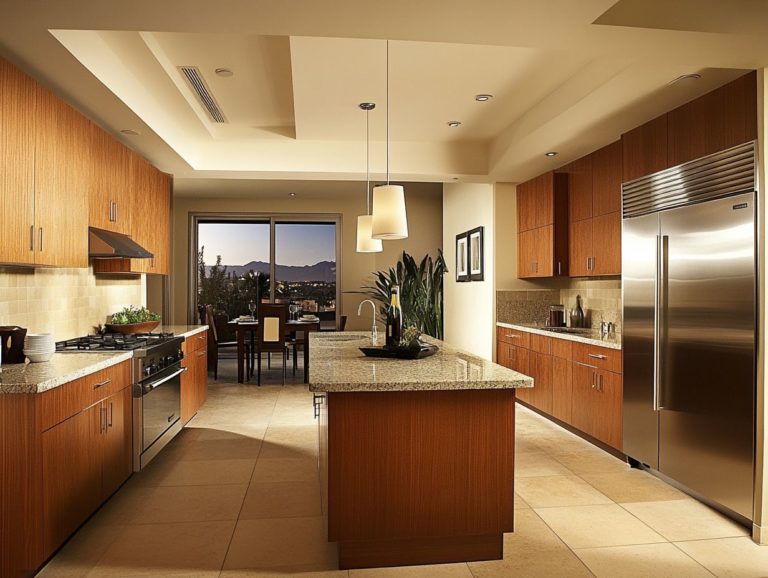How to Choose the Right Material for Kitchen Shelving
Choosing the right material for your kitchen shelving can elevate both functionality and the look of your space.
With options ranging from timeless wood to modern metal and sophisticated glass, each material has its own unique advantages and drawbacks.
Factors such as budget, durability, and maintenance requirements are essential in your decision-making process.
Let’s explore the exciting options for materials that can transform your kitchen!
Contents
Key Takeaways:

Consider your budget and style when choosing materials for kitchen shelves.
Think about durability and maintenance needs to select the right material for your kitchen.
Wood, metal, glass, plastic, and composite materials each offer unique advantages.
Overview of Different Material Options
Selecting materials for your shelves is crucial to enhance your home’s look.
Options like floating shelves and various wood types, such as White Oak and Walnut, can complement any design.
Consider shelf depth, weight capacity, and maintenance to achieve a stylish and functional kitchen.
Aligning these choices with your design vision helps create organized spaces that reflect your style.
Factors to Consider When Choosing Materials
Choosing the right materials requires careful thought about budget, quality, durability, and maintenance.
Understanding these factors can greatly influence your kitchen design and functionality.
Budget and Aesthetic Preferences

Balancing budget and style is key when choosing materials for your shelves.
By selecting budget-friendly options that match your design vision, you can create a stunning look without overspending.
The right materials affect both the appearance and durability of your shelves. Maple offers a sleek look, while Alder gives a warm feel.
Custom floating shelves save space and display decorative items beautifully.
Exploring these options helps blend functionality with style, creating a stylish living area.
Durability and Maintenance Requirements
Understanding how long shelving materials last and how to care for them is key to keeping your space looking great.
For instance, wood shelves need different care than metal or glass. High-quality options like Ultrashelf wood stand out for their strength and easy upkeep.
Metal shelves are incredibly strong and can handle heavy items well. Glass shelves look sleek but can chip or break if not handled carefully.
Proper installation is vital for shelf longevity. Secure shelves distribute weight evenly, which prevents sagging and damage over time.
Regular maintenance, like cleaning and checking for wear, can help all types of shelves last longer and stay attractive.
Wooden Shelving
Wooden shelving, especially custom floating shelves, adds warmth and character to your kitchen.
It’s essential to consider different wood types—like White Oak, Maple, and Walnut. Each type has its own weight limits and care needs, affecting both function and appearance.
Pros and Cons of Wood

Wood shelves offer unique beauty and warmth but require careful maintenance.
High-quality wood can enhance your home’s decor but does need more care compared to other materials.
The natural grain of wood adds character, creating a cozy atmosphere. Reclaimed wood, for instance, brings rustic charm to both farmhouse and modern designs.
However, wood can scratch, warp, and get damaged by moisture, especially in kitchens and bathrooms.
In contrast, metal or laminate shelves resist moisture better but lack the warmth that wood provides.
Metal Shelving
Metal shelving is known for its durability and capacity, making it a great choice for both homes and businesses.
You can find affordable metal shelves that fit into various design styles, giving you a modern solution for your kitchen or pantry.
Advantages and Disadvantages of Metal
Metal shelves are durable and have a sleek look. However, they can rust and offer fewer design choices than wood.
Metal is often used in busy areas due to its strength. Just remember to check for rust regularly, especially in humid places.
While metal can enhance industrial or minimalist interiors, it may not suit traditional styles. Consider these pros and cons to find the perfect shelving that fits your needs and style.
Glass Shelving

Glass shelving has a unique design. It can enhance the look of modern spaces.
This style creates a light and airy feel in kitchens and pantries.
When choosing glass, consider its weight capacity and maintenance needs. This ensures that your shelves are both stylish and functional.
Benefits and Drawbacks of Glass
Glass shelves are beautiful and create an illusion of more space. However, they can be fragile and have limited weight capacity.
While they add a sleek look, glass shelves generally can’t hold as much weight as wood or metal. This makes them less ideal for heavy items.
Cleaning is needed frequently since fingerprints and dust show up easily. Keeping them looking pristine requires regular upkeep.
On the other hand, wood and metal offer sturdier options with less maintenance. However, they may not provide the same open feel that glass does.
Finding a balance between style and functionality is key to choosing the right shelving material.
Other Material Options
Besides wood, metal, and glass, consider materials like plastic, wire, and composites. These budget-friendly options can meet various functional and aesthetic needs.
Each option has unique features that can cater to your design preferences and practical requirements.
Plastic, Wire, and Composite Materials
Plastic, wire, and composite materials offer practical and budget-friendly shelving solutions. Each material has unique characteristics that align with varying weight capacities and design preferences.
These materials are particularly advantageous in commercial kitchen environments or utility areas, where functional organization is key. Plastic shelving is lightweight and moisture-resistant. This makes it the perfect choice for food storage or areas prone to spills.
Wire shelving enhances air circulation, making it ideal for refrigerators and dry storage. Composite options elegantly combine aesthetics with durability, seamlessly integrating into modern kitchen designs while supporting substantial weight.
By understanding these distinctions, you can confidently select the right shelving material that not only meets your functional needs but also elevates the overall look and functionality of your spaces.
Watch this video to learn more about choosing the right shelving materials for your kitchen!
Frequently Asked Questions
What factors should I consider when choosing material for kitchen shelving?
When selecting material for kitchen shelving, consider durability, weight capacity, water resistance, and ease of maintenance. Also, take into account the overall aesthetic of your kitchen and the style of your other fixtures.
What are the most common materials used for kitchen shelving?
The most common materials for kitchen shelving are wood, metal, and glass. Wood provides a natural and warm aesthetic, metal offers a modern look, and glass adds elegance while allowing for easy visibility.
How do I determine the weight capacity of kitchen shelving materials?
The weight capacity of kitchen shelving materials varies depending on the type and thickness. Always check the weight capacity specifications provided by the manufacturer to ensure it can hold the intended items without bending or breaking.
Which material is best for water resistance in kitchen shelving?
For water resistance in kitchen shelving, stainless steel or chrome-plated steel are the best options. These non-porous materials do not absorb moisture, making them suitable for use in humid environments.
Are there eco-friendly options for kitchen shelving materials?
Yes, eco-friendly options for kitchen shelving materials include bamboo, reclaimed wood, and recycled metal. These sustainable materials can add a unique and environmentally conscious touch to your kitchen design.
Can I mix and match different materials for kitchen shelving?
Absolutely! You can mix and match different materials to create a unique and personalized look. Just ensure that the materials complement each other and consider the weight capacity of each to avoid overloading the shelves.





